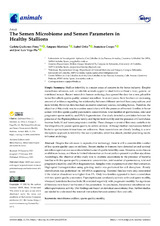The Semen Microbiome and Semen Parameters in Healthy Stallions
Autor
Quiñones-Pérez, Carlota
Martínez, Amparo
Ortiz, I.
Crespo Castejón, Francisco
Vega-Pla, J.L.
Editor
MDPIFecha
2022Materia
MicrobiomeStallions
Sperm quality
Motility
METS:
Mostrar el registro METSPREMIS:
Mostrar el registro PREMISMetadatos
Mostrar el registro completo del ítemResumen
Despite the advances in reproductive technology, there is still a considerable number of low sperm quality cases in stallions. Recent studies in humans have detected several seminal microflora–spermatozoa associations behind some idiopathic infertility cases. However, no studies are available on horses, and there is limited information on the microflora present in stallion ejaculates. Accordingly, the objective of this study was to examine associations to the presence of bacteria families with five sperm quality parameters: concentration, total number of spermatozoa, total and progressive motility, and DNA fragmentation. Samples were cryopreserved after their extraction. High-speed homogenization using grinding media was performed for cell disruption. Family identification was performed via 16S rRNA sequencing. Bacterial families were only considered if the relative abundance was higher than 1%. Only two families appeared to have a correlation with two sperm quality parameters. Peptoniphilaceae correlated positively with total sperm motility, whereas Clostridiales Incertae Sedis XI correlated negatively with progressive motility. No significant differences were found for the rest of the parameters. In conclusion, the seminal microbiome may affect spermatozoa activity. Our findings are based on statistical associations; thus, further studies are needed to understand the internal interactions between seminal flora and cells.

